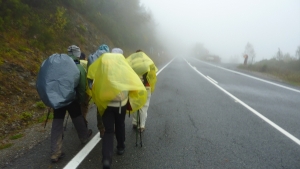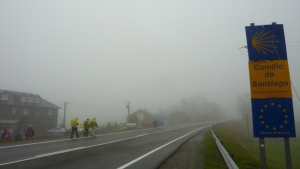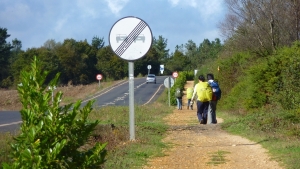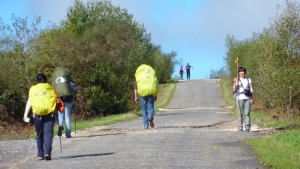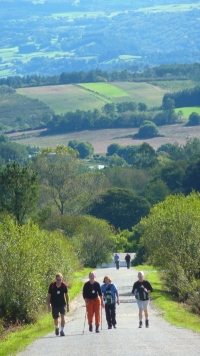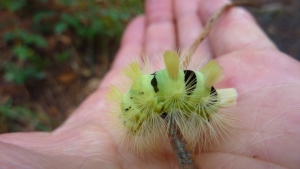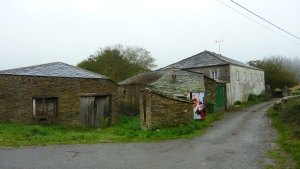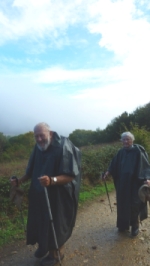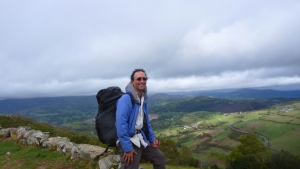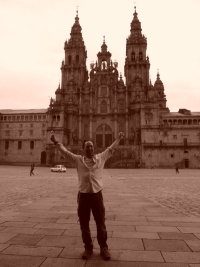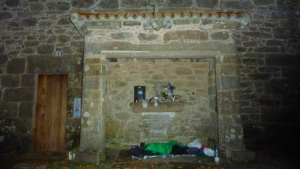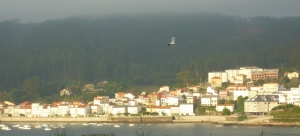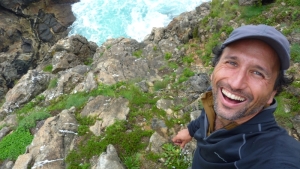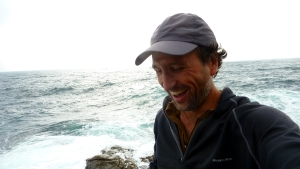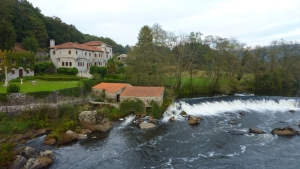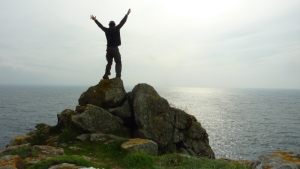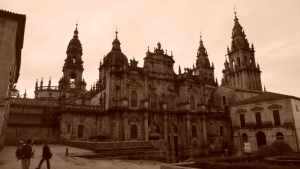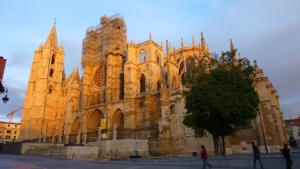
Before ripping into El Camino, let's start by recognizing its many benefits. Next, I'll mention some features that are either good or bad, depending on your values. Then, you'll learn what really sucks about El Camino de Santiago. I'll share a few stories along the way and end with some recommendations.
10 benefits of El Camino de Santiago
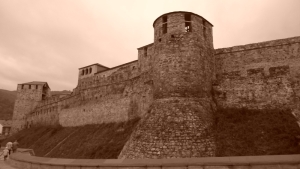
- You can take a shower and sleep in a bed every day for less than $10/day - it's crowded here, so I advise you to book your accomodation in advance.
- You don't need to carry any food because you'll have access to cooked restaurant meals every few hours.
- You don't even need to carry water! You cross piped water about every 45 minutes. You won't need to purify it either.
- No need to carry your trash with you for days since you'll pass a trash can about every 10 minutes.
- As a result of all this, your backpack could be as light as 1 kg (2.2 pounds). To compare, my ultralight backpack on the CDT weighed 3 kg. However, many pilgrims prefer to lug around all sorts of luxuries and end up with heavy backpacks of 10 kg (22 pounds) or more.
- You don't need a map or navigation skills because the route is well marked.
- The wide path lets you walk side-by-side with your companion(s), making for easy conversation.
- You'll never have to bushwhack.
- You'll never have to hitchhike to resupply.
- It's flat, easy hiking nearly everywhere, with occasional gentle climbs/descents. It is graded for cars/bikes (which is even easier than equestrian trails.) - you can rent a car for your trip here.
4 good or bad traits, depending on your perspective 
- It's extremely social. There are lots of interesting people from all over the world to meet and talk with. (Those who prefer solitude will be frustrated.)
- Anyone can do the whole trail on a mountain bike. (Some hikers don't like sharing a path with bikers.)
- You'll walk through 5-20 rustic villages per day. (Those who prefer wilderness will be disappointed.)
- Most Spaniards don't speak English well. Many non-Spanish speaking pilgrims were stunned and frustrated that despite attracting pilgrims from all over the world, the locals have made hardly any effort to learn the international language: English. (You, however, may cherish the opportunity to practice your Spanish. Spanish is my mother tongue so I was happy to speak in Spanish.)
- Only about 1% of El Camino de Santiago is a narrow (1-meter wide) dirt trail; 99% is a road (either a dirt road, 2-track road, paved road with little traffic, or a busy highway). It's almost never a narrow footpath where pilgrims are forced to walk in a single file.
- About half the time you're on a paved road or on a dirt path right next to a paved road. Some of the paved roads have little traffic, but others are quite busy.
- Because you're on a paved road so often, by the end of the day your feet may feel like they've been put through a meat tenderizer. Although I've hiked over 65 km in one day in steep mountains, I found it harder to do 65 km in one day on the flat Camino. My feet just ached too much from all paved roads.
- About 95% of the time, car traffic is within earshot. El Camino often gives you the illusion that cars aren't near because you sometimes can't see the nearby paved road which may have infrequent traffic. However, it takes just one car to remind you that there is indeed a road nearby.
- Amenities distract from any spiritual mission you may have. With endless bars, restaurants, hotels, vending machines, tour groups, you're hardly removed from the "real world." This defeats much of the purpose of living primitively in a search for a deeper meaning or understanding of life. On the other hand, it's nice to have easy access to ice cream.
- The scenery is monotonous. It's endless pastoral farmland everywhere you look. Far in the horizon, you might glimpse some real mountains. The most photogenic places are the towns and villages; since you can drive (or bike) to all of them, there's no practical need to walk between them.
- It's a skin cancer magnet. Infrequent trees mean that a brutal sun is hammering you most of the day. In the summer, it's hard to tolerate.
- Unfriendly commercialism. El Camino has become a big business, where the locals are sometimes unfriendly and seem to just care about getting your money.
- It's a cacophony of sounds. Rumbling 18-wheel trucks, ear-splitting motorcycles, angry barking dogs, blaring music from cafes, honking horns, and ringing cell phones. El Camino assaults your eardrums. At least, there were no jack-hammers. Oh, wait. I walked by one of those too.
- It's hard to take a piss. There's little privacy. Cars and pilgrims are constantly passing you by. After 3 p.m. most pilgrims retire to their albergues (huts) and you'll get more privacy to do your business. Nevertheless, at 7 p.m. one jogger still managed to catch me with my pants down.
Pilgrim: A traveler that is taken seriously. — Ambrose Bierce
El Camino de Santiago's dirty little secret 
Today, El Camino de Santiago is a Christian pilgrimage, but Christianity didn't invent the route. In fact, like many of Christianity's holidays and rituals, the Church usurped and repackaged ancient pagan traditions and called them Christian (like it did with Christmas and Easter). El Camino de Santiago is yet another example of this. It's El Camino's dirty little secret.

Long before Jesus was born, pagans were walking across northern Spain in a born-again ritual. They would finish at Fisterra (the end of the world), burn their clothes, and watch the sun fall into the infinite sea next to La Costa de Morta (the Coast of Death). This ritual symbolized a pilgrim's death and rebirth.
Eventually, Christians claimed to have brought the remains of St. James to Santiago de Compostela. They encouraged Christians to follow the well-beaten pilgrimage path that the pagans had created, but this time in the name of Christianity. This long, rich pilgrimage history brings up an obvious question...
Why is there so much road-walking on El Camino de Santiago?
Even though the trail has existed for thousands of years, it's mostly covered by asphalt now. Why weren't the Spaniards able to preserve the original, rustic trail?
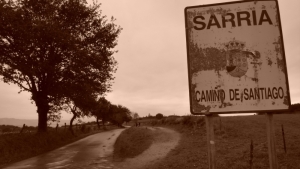
The reason is that although El Camino was incredibly popular during the Middle Ages, it fell out of fashion when the Black Plague, the Protestants, and the Renaissance ruined the pilgrimage party.
When the Spaniards paved roads in the 20th century, they enlarged and paved over most of the dirt roads of El Camino de Santiago. Few complained since few did the pilgrimage during the mid-20th century.
However, about 40 years ago, El Camino became more popular, as hiking generally became popular. Once Paulo Coelho's The Pilgrimage book came out in 1987, El Camino soared in popularity and hasn't stopped since.
In fact, there was an unusual number of Asians on El Camino. I rarely see Asians (or Blacks) on long-distance trails. As I talked to the Asians, I learned they're Korean. Turns out that a Korean wrote a bestseller about her pilgrimage on El Camino, inspiring some 1,500 Koreans to hike the whole route every year.
This explains why Koreans were the first foreigners to buy the rights to translate and sell my book, Hike Your Own Hike. I never understood why thousands of Koreans bought it. Now I know. My book piggybacked on the phenomenon that the Korean fascination with El Camino de Santiago.
Despite all this hiking fervor, the bad news is that by 1987 Spain had paved over much of the historic Camino because the old path took the fastest and flattest way toward Santiago, which is desirable for vehicle traffic.
I asked Luis, a Spaniard who had done the trail four times, why Spain didn't cut a new dirt path toward Santiago and avoid the roads. Given El Camino's immense popularity, surely the Spanish government has enough money (and volunteers) to secure easements and build a primitive, narrow footpath. So why hasn't Spain done it?
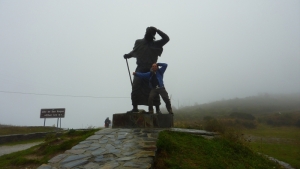
Luis answered simply, "This is Spain."
Although his answer explains everything, it's not a very satisfying answer. It's unclear to me what's the main roadblock for making a narrow trail far from roads. The answer may be surprisingly simple: most pilgrims may prefer it the way it is. Many people accept road-walking; otherwise, El Camino de Santiago wouldn't be the world's most popular long-distance trail.
Just how popular is El Camino de Santiago?

I rarely stayed in the albergues (huts) because I prefer to sleep outside than pay $10 to sleep with many people who snore and make a racket going to bed late. However, 5 km before Santiago, I celebrated by staying at the albergue. When I signed in, I asked the lady, "Is it a busy night tonight?"
"No, only 30 pilgrims are staying here."
"What's the maximum capacity?"
"550."
550?! It looked huge from the outside, but since I arrived at night, I couldn't tell just how enormous this albergue was. There's a series of buildings to house pilgrims. Incredibly, during the summer, they're overflowing.
To be fair, most albergues are far smaller, hosting fewer than 100 pilgrims. Still, one hundred is a lot!
When I received my Compostela (the certificate of completion) in Santiago, I asked one of the four volunteers what's the maximum number of pilgrims the office processed in one day. The answer blew me away: "On one day in August 2009, we processed 1,500 pilgrims."
My mouth dropped. The line was down the stairs and wound around the streets outside. Pilgrims waited for hours to get their piece of paper.
I told the man, "But 2010 is a Holy Compostellan Year (because July 25 falls on a Sunday). You'll surely break the record then, right?"
"Unless we get more volunteers," he said, "We cannot process more than 1,500 per day. We worked overtime to do 1,500. It was crazy!"
It's hard to grasp these numbers, but here's one last attempt. When I yo-yoed the CDT, I didn't find one backpacker during the first 3,000 km of trail. Not one. (I saw just one day hiker, two snowmobilers, and two skiers.) Although I saw a few more backpackers during the last 6,000 km, fewer than 100 backpackers finish the CDT each year. On a summer day on El Camino, it's common that 100 pilgrims finish per hour!
Every year, more than 300,000 pilgrims earn a Compostela (which means they walked at least 100 km). They come from over 100 countries. The volume of pilgrims is simply staggering.
Feeling like Spiderman
One old guy who hiked the Appalachian Trail once told me, "What makes a thru-hike great is that an ordinary person can, with much effort, finish it and feel like Superman."
It's true. Few are good enough for the Olympics, but completing a thru-hike makes you feel like an Olympian.
However, if doing an American thru-hike makes you feel like Superman, then doing El Camino might make an Appalachian Trail veteran feel like Spiderman.
It's not that El Camino isn't physically challenging. The frequent pavement and heat cause many to develop feet, joint, and back problems.
However, the flat terrain and easy access to creature comforts make El Camino de Santiago far easier than any of the Triple Crown trails.
And that's precisely why it's so popular. Most people would rather walk just 20 km on a flat path, eat a warm restaurant meal, and shower and bed at the end of every day than walk 40 km on a steep mountain trail, far from amenities.
Most people are happy with the tradeoff if the price is more road walking and less engaging scenery. I'm not. But hike your own hike.
One thing is certain: as much as I'm not fond of El Camino de Santiago, I celebrate, applaud, and admire anyone who finishes it. I found completing El Camino de Santiago requires more mental toughness than the Triple Crown because El Camino de Santiago is less rewarding to the wilderness lover than the Triple Crown.
Although I'm criticizing El Camino de Santiago, that doesn't mean I don't respect or salute those who hike it. My heart would soar whenever I saw anyone over 65 walking El Camino de Santiago. Their stories were always the greatest and most inspiring.
Comparing El Camino de Santiago with America's Triple Crown trails
Some have asked me to compare El Camino de Santiago with the Triple Crown. The Triple Crown comprises America's three most popular long-distance trails (AT, PCT, CDT).
Let's compare the distances. Most pilgrims start somewhere near the Pyrenees, doing 800-900 km. Pilgrims are impressed when someone from Switzerland, Germany, or Austria does just over 2,000 km. And those who start further become legends. One guy many talked about had walked from Jerusalem, about 6,000 km.
Now compare these distances with the Appalachian Trail (3,000 km), the Pacific Crest Trail (4,250 km), or the Continental Divide Trail (4,500 km). Anyone who does the AT walks 50% more than even the "elite" pilgrims from Austria.
Furthermore, the Triple Crown trails cover relatively isolated, steep mountain ranges. Thru-hikers may have to cover up to 300 km between convenient resupply points. On El Camino de Santiago, you'll never go more than 10 km between resupply points, and it's primarily flat terrain everywhere.
Therefore, one can argue that walking 6,000 km from Jerusalem is comparable to thru-hiking the PCT or CDT because it's flatter and has far more resupply points than the PCT and CDT. By that measure, anyone who thru-hikes the PCT or CDT has god-like hiking abilities by El Camino de Santiago standards.
The point of these comparisons is not to argue that the Triple Crown trails are "better" than El Camino de Santiago but rather to illustrate that they are nearly incomparable! They are different experiences. They're so different that if you like one, you'll probably dislike the other. Hence, this explains why I think El Camino de Santiago sucks.
Some Camino fans will argue that my way to Santiago had two major flaws. First, the alternate through Los Picos de Europa and Asturias, while scenic, made me miss out on nearly half of El Camino Frances, so my journey wasn't typical. Second, by avoiding albergues, I missed out on the social aspect of El Camino, which, for many pilgrims, is the best part of the journey.
Although I understand these criticisms, I hiked with enough pilgrims and stayed at enough albergues to get a good idea about the social side of El Camino. It's true: the social opportunities are precious and unique. Unlike America's Triple Crown, El Camino attracts a truly international crowd. However, I want more than cool international people on a trail. I can get a multicultural experience on the New York City Subway. A trail, for me, should take me away from civilization and deep into nature. On that metric, El Camino fails miserably.
Going to the very end: Fisterra
About 5% of the pilgrims don't finish in Santiago but continue walking another 88 km to the end of the world: Fisterra. The Spanish call the place Finisterra, but the local Gallegos, who have their language in the Galician region of Spain, call it Fisterra. The Romans gave its name because they believed it was the end of the earth.
As brilliant as the Romans were, they didn't have GPS. As a result, Fisterra is a big hoax. Although it may feel like you're standing on the edge of the world in Fisterra, it's not the westernmost part of Europe. That point is hundreds of kilometers further south near Lisbon, Portugal.
What's even more galling is that Fisterra is not even the westernmost point in Spain! The actual westernmost point is a few kilometers to the north. What a ripoff!
Fortunately, I knew all this as I walked there, so at least I knew that I was being an idiot.
Once you get there, however, you can see why the Romans thought this was the ultimate land's end. It feels like you're standing on the edge of the planet.
You'll never believe who did El Camino de Santiago in reverse
As I stood at Fisterra, I thought about a man who also stood there and would later become the President of the United States. This man was desperate after crossing the Atlantic Ocean: his ship was leaking and would soon sink. Fisterra was the first piece of ground available, so he landed there. However, his desperation didn't stop. The future of the United States depended on him. If he failed on his mission, the United States might collapse.
He did something incredible with no ship: he followed El Camino de Santiago in reverse! He hurried as fast as he could, eager to cover as much ground as possible. He was so hurried that he didn't even have time to see Santiago de Compostela, something he would later deeply regret. But it didn't matter at that moment – he had to save his nation, and time was running out.
He crossed all of Spain, often on El Camino de Santiago, went over the Pyrenees, through southern France, and to Paris! All of it over land and at a ferocious pace. Once in Paris, he hurried straight to the highest office in the land. His mission?
To beg.
He begged the French for money and weapons to kill the British. The French hesitated. They weren't pleased that the American diplomat didn't speak French (bien sûr!). Nevertheless, the French agreed to help this rebellious American terrorist.

It was June 1779, three years into the American Revolutionary War. Without French assistance, the United States may not have become the nation it is today. This partly explains why Americans returned the favor when they helped to liberate France from the Nazis 165 years later.
This man, who traveled much of El Camino de Santiago in reverse, from Fisterra to Paris, to save our nation, returned a hero and became America's first Vice President, serving under George Washington. Later, the United States elected this man to become the second President of the United States. His name was John Adams.
Beware of the bitch at the end of the world
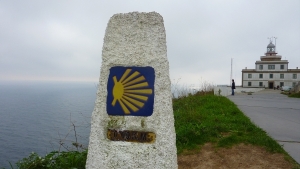
"Why not?" I asked in my fluent Spanish.
"You don't have enough stamps on your credential. The trip from Santiago to Fisterra takes three days, so you should have three stamps. You only have one stamp. So you can't stay."
"Santiago is only 88 km away. It doesn't have to take three days. It took 48 hours to do that distance. Besides, I never stay in albergues, I sleep outside. Do you want me to bring all the pilgrims here who saw me walking as witnesses that I walked here? Or do you want me to show you the photos of the last 88 km?"
"No. You should have gotten your stamps even if you don't stay at the albergues."
"But sometimes the albergues are 100 meters off El Camino. Do I have to go out of my way for a stamp?"
"Yes, you should."
"What about the fact that at one of the albergues, there was a sign saying the woman with the stamp wouldn't return until 5 p.m.? I was there at 2 p.m. Should I have waited three hours for her to get a stamp?"
The woman shrugged and said, "Those are the rules. Without stamps to prove where you were, it's possible that you took a bus all the way here."
I smiled. Her logic was funny, especially since she might be able to smell that I hadn't taken a shower in a couple of days. She might have noticed the disheveled clothes that I've been wearing for the past 18 months of travel.
I should have put my shoes on her table to show that they had no more soles and had holes in them because they were the same shoes that had walked to the top of a volcano in Nicaragua, ran a half marathon in Estonia, traversed a Bulgarian mountain range, climbed the tallest mountain of Ukraine and Western Europe, visited over 35 European countries, and crossed the Pyrenees and El Camino de Santiago. I show off the shoes in the video below...
Instead of telling the evil gatekeeper all that, I looked at her silently, wondering if reason would enter her skull.
She glanced at my Yankee passport, "Given the country you're from, you should know better. Your country has strict entry rules, so you should be able to handle what we ask you to do."
I thought about showing her my French and Chilean passports (my dad was French, and my mom is from Chile). However, I preferred that she label me an ugly Yankee rather than a French (or Chilean) snob.
So I sighed, stood up, and left.
She registered the next pilgrim (who looked so clean and carried a tiny day pack that might make you think he had just walked off a bus but was registered because he had the correct number of stamps).
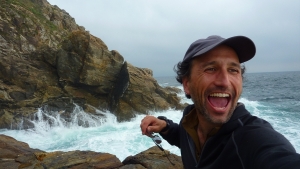
While she was busy with him, I sneaked into the albergue. The tyrant missed me. I giggled like a child as I took a hot shower.
I dried off, said farewell to all the pilgrims I had met along the way, and left the albergue smiling at the bitchy guard woman. I should have flipped her off, but my wet hair clued her in that I was having the last laugh.
The ending of all the long-distance trails that I have done has always been bitter-sweet. With El Camino, however, it was only sweet. I had no sadness that the journey had come to an end. With the Pyrenees, I was happy to have done it and sad that it was over. With El Camino, I was happy I had done it, and I was happy it was over.
Video of El Camino de Santiago
Skip the first two minutes of the video below (which shows the end of my trek across the Pyrenees), so you'll see photos from El Camino de Santiago, including the part where I deviated from El Camino Frances to go into Los Picos de Europa.
Recommendations
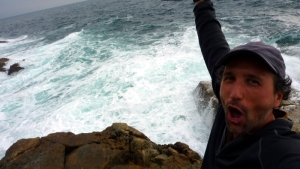
- Don't go in the summer. First, it's the most crowded period. Albergues are usually packed, and people can get cranky. Second, summer in Spain is brutally hot. Go during any other season, even winter, which sees little snow on most of El Camino.
- Unless you love road walking, bike El Camino de Santiago. Mountain bikers can travel the same path the walkers use. Most say you only go twice as fast on a bike because the muddy parts, climbs, and irregular surface slows you down. However, a decent mountain biker should be able to go three times faster than a walker. Typical bikers cover 40-80 km daily (most walkers cover 20-40 km). A good mountain biker could do 100 km daily, allowing you to go from France to Santiago de Compostela in less than 10 days.
- It's also possible to use a road bike because there is almost always a paved road parallel to El Camino. Fast road bikers can cover 150 km daily, allowing you to do the whole Camino in less than a week. However, I don't recommend this because biking on narrow paved roads with car traffic is dangerous. Instead, take a mountain bike and stay on El Camino.
- Hike a similar route that I took. Start in Hendaye, France. Follow El Camino del Norte until you're north of Los Picos de Europe, and then climb up (south) into that national park. Once you're in the middle of Los Picos de Europa, head west, crossing the Asturias region, connecting many existing paths. Continue until you cross El Camino Primitivo (yet another designated path to Santiago), or until you get to Ponferrara or Lugo, you'll rejoin El Camino Frances. From there, join the herd to Santiago. This is the best backpacking route because it focuses on scenery, solitude, wilderness, and mountains. It's certainly the most brutal way to Santiago, but it's worth it.
- Consider hiking El Camino del Norte. As I've mentioned, El Camino Frances is just one path to Santiago. The northern route runs near the coast, offering ocean and mountain views nicer than the views on El Camino Frances. You'll have more up-and-down terrain, but it's worth it for the views and varied geography. Also, the Northern Route is less famous than the Camino Frances, so you'll enjoy less competition for the facilities. However, there are not that many albergues, so they can fill up quite quickly in the summer, so be prepared to camp if you go during the summer. Although it's not as well marked as El Camino Frances, it's reasonably well marked, so you won't have to invent some route through Asturias as I did. It has roughly the same amount of road walking as the Camino Frances. This may be the best way to go for those who want a less crowded Camino yet still want to taste the experience.
- Hike the Pyrenees instead. Forget El Camino. Do the Pyrenees. It's far more challenging but far more rewarding. I adored the Pyrenees. The best trail is the HRP (High Route Pyrenees), next is the GR 11 (goes on the Spanish side), and the least amazing (but still great) is the GR 10 (on the French side). There are still plenty of comforts in the Pyrenees thanks to all the refugios (where you can get a shower for $5, a meal for $15, and a bed for $35). The scenery and adventure are as great as the John Muir Trail.
Alternatively, you can join one of the tours and go hiking accompanied by a transfer and a guide:
→ Full-Day Spiritual Pyrenees Adventure from Lourdes
→ Pyrenees Mountains & Medieval Towns Small Group Day Trip from Barcelona
→ Pyrenees Hiking from Barcelona
See the books below.
Be realistic!
Many have romantic visions of El Camino that aren't realistic. The media doesn't help: one brochure about El Camino with 50 photos showed photos of civilization (e.g., towns, churches, bridges) about 80% of the time! Only 10 photos showed El Camino itself, and none showed El Camino on a paved road. Photos on websites also emphasize man-made structures and not nature, hiding most of the everyday reality of El Camino.
Let's hope you learned about the side of El Camino de Santiago that few discuss. If you decide to do El Camino de Santiago, at least you will know what you're getting into. Happy trials! Er, I mean, trails!
Buen Camino!
Alternatives to El Camino Frances Podcast
Susan Alcorn has written a couple of books about El Camino de Santiago.
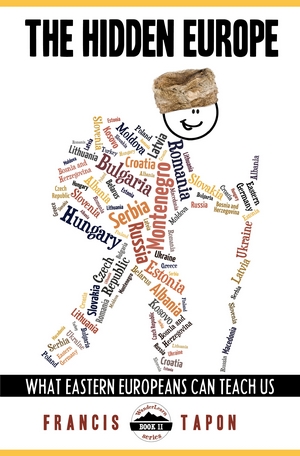
If you appreciate my writing or perspective, then become one of my patrons at Patreon. Also, please sample a few chapters from my two books:
Book 1: Hike Your Own Hike: 7 Life Lessons from Backpacking Across America
Book 2: The Hidden Europe: What Eastern Europeans Can Teach Us.
This article prompted La Vanguardia (the leading newspaper in Catalonia, Spain) to write an article about my experience on El Camino. If you can read Spanish, read the La Vanguardia article.
To comment on this article, scroll down below or visit the WanderLearn Forum.
Some critics in the Comments section below have tried in one way or another to put me down for being an American. I hold three passports (USA, France, and Chile). I'm a world citizen. Criticize the article, but don't think I'm an idiot because I'm an American. I'm an idiot because my dad was French, my mom is Chilean, and I was born in the United States.
And for those who think that I don't think that hiking is transformative, watch my TEDx Talks:
Epilogue
After El Camino, I:
- Drank some port wine in Porto, Portugal
- Camped by the river in beautiful Salamanca, Spain
- Searched for a barber in Seville
- Stayed with hippies in a cave in picturesque Granada
- Hitchhiked 300 km with two cops to Valencia
- Reunited with friends in Barcelona
- Skydived in Empuriabrava, overlooking the Mediterranean and the Pyrenees
Read my other articles about hiking in Spain
- Overview of my plan to walk across Spain twice.
- Overview of El Camino de Santiago, including maps!
- Details and photos about my detour to Los Picos de Europa
- Part 1 of my fantastic backpacking trip across the Pyrenees
- Part 2 of the Pyrenees trek
Rick Steves video on El Camino de Santiago
Rick Steves is a far more politically correct traveler than I. He's too wise to dare to criticize a foreign culture. He filled a nice video that shows scenes from the trail. Let's end on a positive note from Rick.
El Camino de Santiago Guidebooks
Some think I'm trying to discourage everyone from hiking El Camino de Santiago. Wrong.
The purpose of this article is to (a) share my personal opinion and (b) discourage hikers who (like me) prefer walking in the wilderness.
However, if, after reading this article, you still believe El Camino is for you, then it probably is! Go for it! Pick up one or more of these helpful guidebooks:

